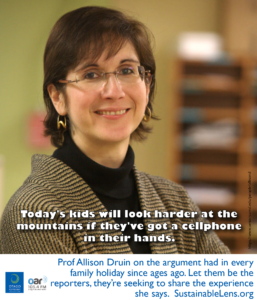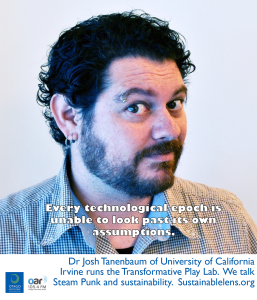We’ve got to start with the large to be able to connect the dots of excellence.
Professor Allison Druin is a Professor in the iSchool and Chief Futurist for the Division of Research at University of Maryland. She has been a leader in the the use of children as design partners, which has been widely applied, including to digital libraries for children (eg ICDL). She is currently seconded to the National Park Service, where she is Special Advisor for National Digital Strategy.
Talking points
With an inventor scientist father and an artist mother I’m a mix between the two of them
My undergraduate degree is in graphic design…A wonderful thing, I always say to people, if you want a real degree: problem solving, creativity, exploration – go get yourself a degree in design, it’s incredible.
I realised that I think like a designer -sometimes visually, sometimes problem solving – but really it’s about what are the parameters in front of me, how can I think out of the box to make something better than it is today.
Then at MIT, in my head I was translating from design-speak to technology-speak.
Not just how technology affects children but how children affect the design of technology
I was a big proponent – back when this was a bit of the lunatic fringe – of really hearing the voices of users as designers, as participants, full participants in the design process.
Rarely do you get a chance to ask kids who don’t have a lot of experience with technology, how do you tell stories? Why do you tell stories? What matters to you with stories? and then to work with them to figure out what that means in terms of new technologies.
It’s a people-led process – its understanding the needs of people, the desires of people, it’s also understanding how processes work, and how they are broken. And where you can bring solutions in that make change
We’re an information-centric world – the scale and speed that information moves, and we need better solutions, we can’t just keep doing the same things faster.
When we do amazing research for a particular population, it spreads like wildfire to what the rest of the world needs
The sooner you can get kids into the design process, the better the outcome will be, and the shorter the process will be in terms of back-end testing.
The notion of cultural tolerance was always underneath the surface of everything we do.
It was never about how do we make kids better readers, it was always how do we help people think about each other, oh and by the way, make them a better reader at the same time.
National Parks Service…a long time partner…maybe it is time for me to come in and think about a national strategy
How do we make it so that kids have a lifelong experience with parks? The pre- and post- experiences can be enhanced with new technologies
Today’s kids will look harder at the mountains if they’ve got a cellphone in their hands.
They’re thinking deeply about what is it that I am doing so that then I can report back to my friends.
Kids have a hard time not being able to be reporters themselves, not being able to share that experience.
If we do let our technology separate us from our physical world too much, that is a bad thing, but with embedded, mobile, ubiquitous technologies we can have physical/digital switching seriously, without a context collapse.
So what sort of language do we use with the Park Service about digital?
What does it mean to have 24/7 to the front door of the parks? Traditionally we built larger and larger visitor centres with beautiful exhibits, but what happens if the mobile app is the front door?
What would it mean if kids could digitally tag a landscape – to tell other kids this is a really cool place to go?
The messages, themes, are really important – the parks are about stewardship, about learning. The parks are not necessarily glorified vacation spots.
The parks are our best idea in education – they’re about teaching the American public that we need to be stewards of our own environment, or else there’s not going to be an environment.
Traditionally we’ve not been able to implicitly share these themes – some administrations haven’t wanted us to focus on climate change or the science behind things. Thankfully in more recent times we have been able to say the science matters, climate change matters, how do we look to ensure we are preserving
This goes for digital too – how do we look to digital to preserve what we know and what we care about?
The first innovation of the Park Service was the campfire (talks), before that they were really just to protect the land from poachers. In the campfire discussions we started talking about the stories behind the wilderness, the culture and the heritage that we have.
(Success) People taking up the methods: children in the design process.
People don’t question why we need to have children at the design table anymore, they just question why we haven’t done it sooner.
(Activist) I think all good academics, researchers, thinkers, are activists. Because we have to share ideas, we have to share what we are thinking. And we have to convince people that what we are doing matters, is unique and truly is a contribution.
(Motivation) Being able to help make change in this world.
CHI Conference (of which Allison is 2016 co-chair) theme is CHI for Good.
Making a little bit of change is going to make the world a little bit better in the long run. It’s not about making money, it’s not about better law, it’s about making people’s lives better.
We’re in a field HCI Human Computer Interaction, that starts with humans,
I’ve never seen such a uniformly positive response to a conference theme in 30 years of coming to this conference.
(how will it stick, not just be the year CHI was good) People really care deeply about change, and keeping that activist-change idea in the CHI community.
We’ve found that the impactful research is where you create innovative technologies that have broad impact.
(Challenges) HCI at scale.
It’s not about one type of user, one type of interaction. How do we work for multitudes of users, in multitudes of contexts, with multitudes of data.
(Miracle) I use this question. My most favourite answer was from a kid who I asked if you could wave a magic wand in your library, what would it be? And he didn’t know what a magic wand was – he had learnt to read reading his Mom’s magazines in the beauty shop. Once I had explained – if you could just change something, what would it be? He said, “I’d put grass on the floor of the library”. I said “what?” and he said “I’ve always been afraid to sit in the grass and read a book where I live, and that’s what I’ve always wanted to do”. So if I could wave a magic wand, I’d give grass everywhere so kids could feel safe, to learn, to be quiet, to explore, to do whatever they wanted, to sit and read a book.
That’s the challenge – HCI, technology at scale. When I got to the Park Service one of my colleagues said maybe you should start with one small thing and grow it. But I said that’s the problem, we’ve been doing that for too many years, we’ve got to see the larger picture. We’ve got to start with the large to be able to connect the dots of excellence.
We do so many wonderful things in this world, but they don’t seem to be connected to the next wonderful thing. In those connections, that glue, that’s where change can happen.
Working with children as design partners – it’s the surprises that make it worth doing everyday.
Could I have imagined that a kid would ask for grass on the floor the public library?
What does that mean? Can technology help? I made a digital library that makes it as fun to do the reading as the searching.
(Advice) Be a futurist. If all of us collectively could not just try and predict the future, but really try and prepare for it. And in preparing for the future we do what matters today – and the rest is commentary.
My children insist I put up this one too:
This conversation was recorded at CHI2016.



